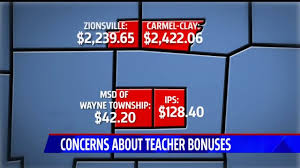
Before we go anywhere, let’s get one thing straight right off the top; the point of what I am about to lay out is not about the money. I repeat–it’s not about the money.
Ok, with that understanding, let’s go on.
Indiana recently moved to begin paying teachers performance bonuses. The amounts teachers earn, or don’t earn, are figured using a formula based on their districts’ scores on the controversial ISTEP test. Essentially, the payouts are calculated not unlike grading on “the curve.” In other words, school districts are in competition with one another for their portion of the pool of bonus monies.
Earlier this year, when the Indiana Department of Education released the amounts of the performance bonus grants that teachers in each school district across the state would be paid, the dollar amounts were eye opening to many, but came as little surprise to those of us who are in the trenches of education. By and large (with a few exceptions), the bonus pay out amounts mirror the average socioeconomic situations of the students in the various districts. It is no secret that more affluent school districts tend to score better on standardized tests than those districts with higher poverty rates. Again, there are always exceptions to this, but they are just that, exceptions, and are comparatively rare. So when the teacher bonus payouts were announced, it revealed a clear delineation between the haves and the have-nots.
The sums of the payouts are not earth shattering, nor are they the issue. The difference between the amounts and the underlying messages that those differences send are the issue.
The highest bonus payouts in the state went to Carmel and Zionsville (teachers there received bonuses of almost $2,500). Is it a coincidence that those two districts happen to have among the highest average family incomes in the state? Again, let me be clear, I don’t begrudge the teachers in Carmel, Zionsville, Hamilton Southeastern, or any other district that got the bigger payouts. Those teachers earned their bonuses. I am certain those districts are full of excellent and deserving teachers. But what about Wayne, IPS, Warren or Decatur Townships, whose teachers received bonuses of less than $200? What about the districts whose teachers received no bonus at all? Do you really believe that the teachers in the Carmels and Zionsvilles of the state do a 10 times better job than the teachers in the Warrens and the Decaturs? I don’t, not for a minute. I know there are teachers working near miracles in those struggling school districts.
The problem with this type of merit pay system is that it assumes an equal playing field when that is far from the reality.
Carmel, Zionsville, and Hamilton Southeastern, for example, have free and reduced lunch rates of less than 25%. Decatur, Warren, Wayne, and IPS have free and reduced rates of more than 60%. Poverty and home life play a large role in student performance. Yet we judge teachers as if we are all given an equal group of students with which to work.
Do you think if Carmel and IPS switched teaching staffs for a year that the scores of IPS students would suddenly skyrocket and the scores of Carmel students would somehow plummet? Of course not. There are excellent teachers in both districts, but the student factors those districts deal with are so different it makes it impossible to compare the merits of the work of their teachers to one another using standardized test scores. Yet, that is exactly what our current system does.
I teach in Decatur Township. I “earned” a $178 bonus this year. It’s not about the money. It is about the not so subtle implication that exists within the more than $2,000 dollar discrepancy between my bonus and those of the teachers in districts with a level of affluence my students can only dream about. Those teachers and students are not 10 times better than ours but, often, their socioeconomic situation is 10 times better, if not more.
The only way to determine a fair merit bonus system for teachers is to test each schools’ kids at the beginning of the year and again at the end of the year and see how much each teacher’s students grew that year. Then award teachers based on what they actually taught their students that year. I honestly don’t think you’ll find many teachers who’d scoff at that kind of accountability system. That type of system compares apples to apples and gets right to the point.
Stop this nonsense of comparing incomparable school districts and pitting them against each other in a Hunger Games-like competition for funds.












